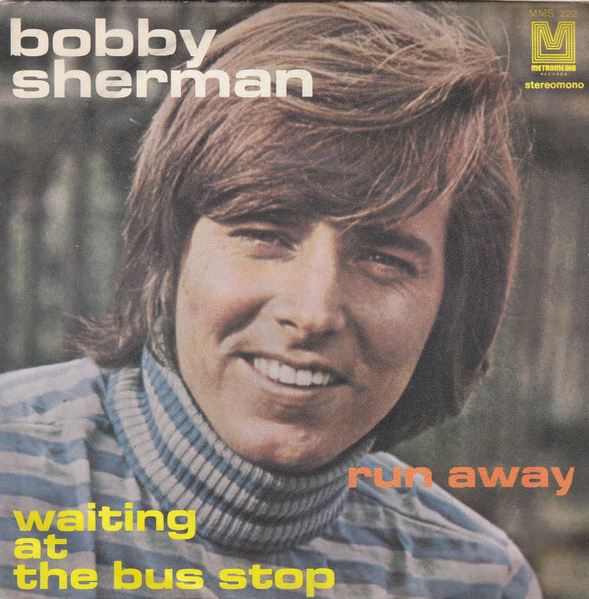
Released in August 1971, “Waiting at the Bus Stop” stands as a charming testament to Bobby Sherman’s enduring appeal as a teen idol and pop singer. Issued by Metromedia Records, the single arrived at a time when Sherman’s career was transitioning amidst the changing landscape of early 1970s music. Known for hits like “Little Woman” (1969), “La La La (If I Had You)” (1969), “Easy Come, Easy Go” (1970), and “Julie, Do Ya Love Me” (1970), Sherman had captured the hearts of young audiences with his wholesome image and heartfelt performances. While musical trends were shifting toward soft rock, singer-songwriters, and more introspective styles, Sherman’s bright pop sensibilities continued to resonate, particularly among teenage fans.
Chart Performance and Reception
“Waiting at the Bus Stop” achieved moderate commercial success, peaking at No. 31 on the Billboard Hot 100 and climbing to No. 15 on the Billboard Easy Listening chart. The single also performed strongly in Canada, reaching No. 4, demonstrating Sherman’s continued appeal in international markets. While it did not reach the chart-topping heights of his earlier hits, the song reinforced Sherman’s place in the pop music scene and showcased his ability to adapt to evolving tastes while maintaining his signature sound.
Songwriting and Production
Co-written by Bobby Sherman and Georg Tobin, and produced by Ward Sylvester, “Waiting at the Bus Stop” is characterized by its upbeat pop melody and nostalgic storytelling. Unlike many of Sherman’s previous singles, this track saw him actively contributing to the songwriting process, offering a personal touch that lent authenticity to the narrative. The song’s B-side, “Runaway”, while less well-known, complemented the single and provided fans with another example of Sherman’s melodic charm.
The production of the track reflects the polished pop sensibilities of the era. Sylvester’s production combined bright, catchy hooks with a folk-inflected melodic structure, creating a sound that was both accessible and emotionally resonant. Although the identities of the session musicians on the recording remain largely undocumented, their skilled performances contribute to the single’s warm, nostalgic feel. The inclusion of “Waiting at the Bus Stop” on Sherman’s 1971 album Portrait of Bobby further emphasized his desire to expand his musical range and present a more mature artistic persona.
Cultural and Career Context
In 1971, Bobby Sherman was juggling multiple facets of his entertainment career. Following his success on the television series Here Come the Brides (1968–1970), he took on the lead role in the short-lived sitcom Getting Together (1971–1972), a spin-off of the popular Partridge Family. Meanwhile, his music continued to resonate with fans through frequent features in teen magazines such as Tiger Beat and 16 Magazine. Sherman’s music maintained its appeal to a young audience despite the decline of the bubblegum pop trend, highlighting his ability to adapt to a competitive and evolving music industry.
“Waiting at the Bus Stop” emerged during a period when nostalgic, storytelling-driven pop songs were gaining popularity. The early 1970s were a time of social unrest, marked by the Vietnam War, economic uncertainty, and the rise of youth counterculture. Against this backdrop, Sherman’s lighthearted, relatable narratives provided listeners with comforting musical escapism. The song’s focus on simple, everyday experiences like waiting at a bus stop created a universal appeal, allowing fans of all ages to connect with its message of anticipation, hope, and human connection.
Creation and Artistic Intent
The decision to create “Waiting at the Bus Stop” was a calculated effort by Metromedia Records to keep Sherman relevant in a changing music market. The label recognized the need to evolve Sherman’s sound to align with the maturing tastes of his audience while still leveraging his established teen idol persona. Collaborating with songwriter Georg Tobin, Sherman contributed to the lyrics and melody, ensuring that the song reflected his own artistic voice and personal sensibilities.
The everyday setting of a bus stop was deliberately chosen to evoke a sense of familiarity and emotional resonance. By grounding the song in a relatable scenario, Sherman and Tobin crafted a narrative that appealed to both young listeners experiencing the ups and downs of adolescence and older fans who appreciated the song’s simplicity and sincerity. This approach allowed Sherman to maintain his signature charm while demonstrating artistic growth and maturity.
At the time of the song’s creation, Sherman was 28 years old, balancing a busy career, personal life, and the pressures of remaining relevant in a rapidly shifting musical landscape. His involvement in the songwriting process suggests a desire to infuse his music with authentic emotion, drawing from his own experiences of longing, patience, and anticipation. The song’s themes of connection and waiting mirrored not only the experiences of his fans but also Sherman’s reflections on his personal and professional life.
Musical and Lyrical Themes
Musically, “Waiting at the Bus Stop” combines bright pop melodies with subtle folk influences, creating a warm and inviting sound. The song’s structure is straightforward yet effective, with catchy hooks and a singable chorus that draws listeners in. Lyrically, the track captures the universal feelings of anticipation and hope, painting a vivid picture of a simple moment imbued with emotional significance. The storytelling aspect of the lyrics allows listeners to immerse themselves in Sherman’s narrative, experiencing the joy and longing conveyed through his vocals.
The song’s nostalgic tone reflects the broader trends of early 1970s pop music, where songs often explored relatable, everyday experiences rather than grandiose or abstract concepts. This approach resonated with audiences seeking comfort and familiarity during a period of social and political upheaval. By focusing on a small yet meaningful moment, Sherman tapped into a shared human experience, creating a connection that transcended age and background.
Legacy and Cultural Impact
While “Waiting at the Bus Stop” may not have achieved the iconic status of Sherman’s earlier hits, it remains a beloved example of his ability to blend catchy pop melodies with relatable storytelling. The song captures a specific moment in early 1970s pop culture, reflecting both Sherman’s personal artistic evolution and the tastes of his audience. Its moderate chart success and enduring appeal in Canada demonstrate that Sherman’s music continued to resonate even as musical trends shifted.
The track also highlights Sherman’s growth as an artist. By co-writing the song and engaging in the creative process, he moved beyond the constraints of teen idol pop and began exploring more personal, narrative-driven themes. This evolution would inform his later work and solidify his reputation as a versatile performer capable of connecting with audiences on multiple levels.
“Waiting at the Bus Stop” also serves as a cultural time capsule, capturing the essence of early 1970s pop music. Its lighthearted yet poignant narrative offers insight into the everyday experiences and emotions of the era’s youth. For contemporary listeners and collectors, the song provides a nostalgic glimpse into the musical and social landscape of the time, making it a valuable addition to any Bobby Sherman or classic pop music collection.
Conclusion
Bobby Sherman’s “Waiting at the Bus Stop” remains an enduring testament to his talent, charm, and ability to evolve with the changing musical landscape. Released at a pivotal moment in his career, the single combines relatable storytelling, catchy pop melodies, and emotional authenticity to create a track that resonates across generations. Its moderate chart success, inclusion on the album Portrait of Bobby, and continued appreciation by fans underscore Sherman’s lasting influence on pop music. For those exploring the rich history of early 1970s pop, “Waiting at the Bus Stop” offers a delightful and nostalgic listening experience that continues to captivate audiences more than 50 years after its release.
Video
